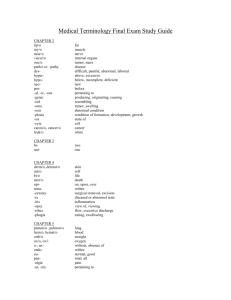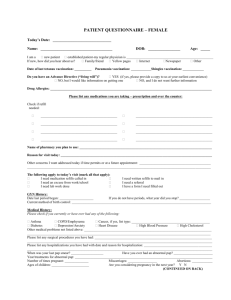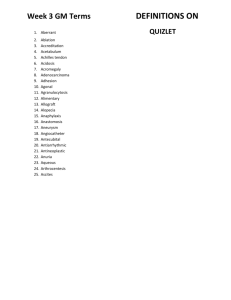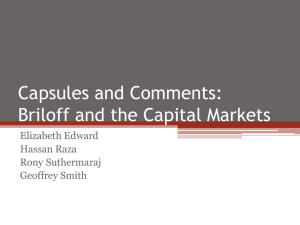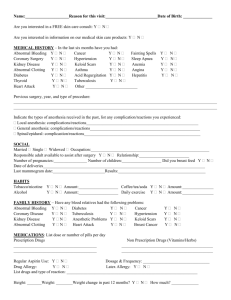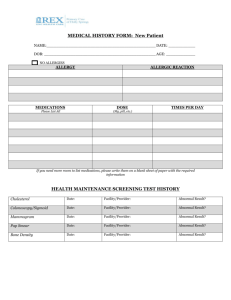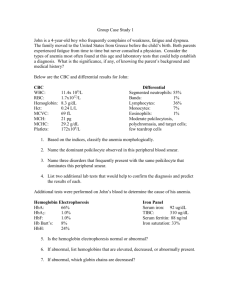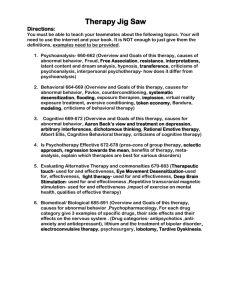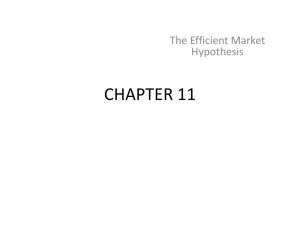Evidence across Asia
advertisement
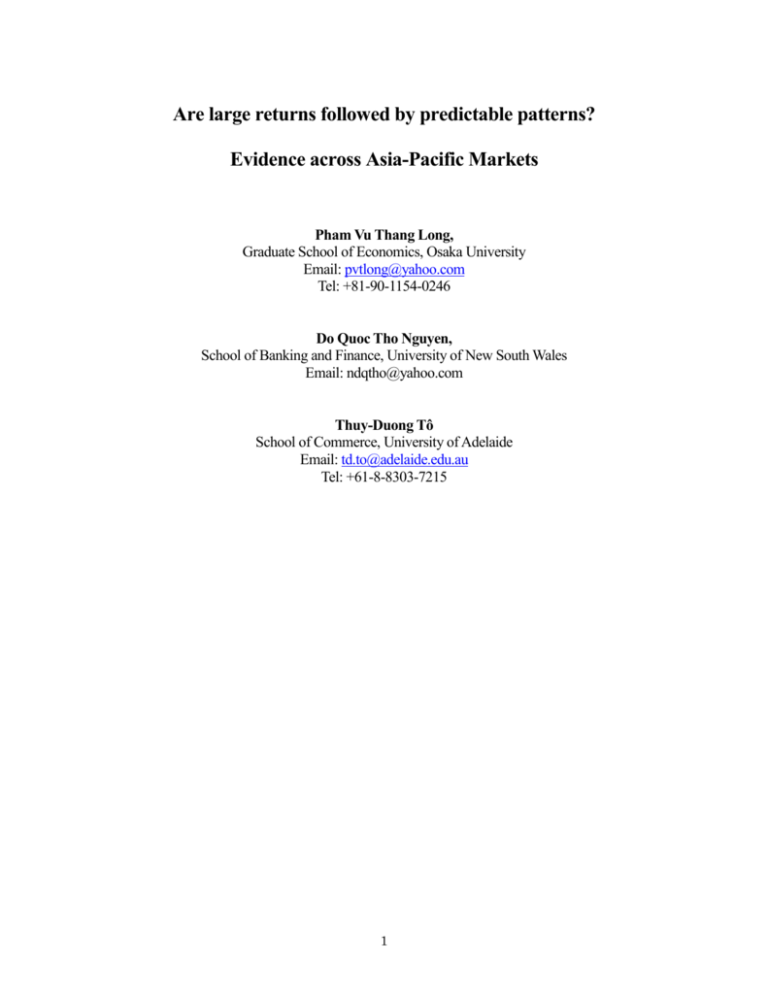
Are large returns followed by predictable patterns? Evidence across Asia-Pacific Markets Pham Vu Thang Long, Graduate School of Economics, Osaka University Email: pvtlong@yahoo.com Tel: +81-90-1154-0246 Do Quoc Tho Nguyen, School of Banking and Finance, University of New South Wales Email: ndqtho@yahoo.com Thuy-Duong Tô School of Commerce, University of Adelaide Email: td.to@adelaide.edu.au Tel: +61-8-8303-7215 1 ABSTRACT This paper aims to expand the overreaction literature by examining whether the price reversals occur in the short-term period i.e. three days and longer term period i.e. up to twenty days following the large one-day price changes in Asia-Pacific markets over the period 2001 to 2005. Our results based on firm data in three AsiaPacific markets, namely, Australia, Japan and Vietnam indicate the followings. First, stock prices tend to be reversed after large price changes. Second, in the case of large price declines, investors may earn profit from exploiting the phenomena of price reversals, however, the profit is not worthy to exploit since it is less than the profit from passive funds. This result is supportive of the weak-form of EMH. Third, we find mixed evidence of whether the price reverses or not over the longer term period. Forth, market conditions, i.e. bear or bull, may not explain the magnitude of price reversals. Finally, the dynamic measures of large price changes based on individual firms provide most consistent evidence across markets which are supportive of short-term price reversals and overreaction hypothesis. JEL classification: G12, G14 Keywords: Event Studies; Information and Market Efficiency; Overreaction; Price Reversals; Asia - Pacific stock markets. 2 INTRODUCTION Fama (1969) introduced well-known efficient market hypothesis (EMH) with three forms: strong form, semi-strong form and weak form. Stock prices at any time fully reflect all available information in the strong form, all public available information in the semi-strong form and historical information in the weak form of EMH. Two important implications of EMH are that future stock prices are unpredictable and expected stock returns can only be determined by rational asset pricing models. Evidence from empirical studies has suggested that stock prices do not always accurately reflect available information. In particularly, research in experimental psychology has suggested that “most people overreact to unexpected and dramatic news” (Debondt and Thaler (1985)). Motivated by this, Debondt and Thaler (1985) develop the overreaction hypothesis which suggests: “Extreme movements in stock prices will be followed by subsequent price movements in the opposite direction”, and “The more extreme the initial price movement, the greater will be the subsequent adjustment” (Debondt and Thaler (1985)). The overreaction hypothesis implies a violation of weak form of EMH, i.e. future stock prices cannot be predicted from past stock prices. A great number of studies have assessed whether short-term price movements in the opposite direction or price reversals occur following one-day extreme price movement. Some notable papers in this area include Brown, Harlow, and Tinic (1988, 1993), Atkins and Dyl (1990), Bremer and Sweeney (1991, 1996), Cox and Peterson (1994), Park (1995) and Bremer et al. (1997). Stock prices are generally found to be reversed following one-day sharp declines. Exceptional case is Cox and Peterson (1994), whose study finds that abnormal returns of longer term (4 days to 20 days) are negative after a large one-day decline. This paper aims to expand the overreaction literature by examining whether the price reversals occur in the short-term period i.e. three days and longer term period i.e. up to twenty days following the large one-day price changes in Asia-Pacific markets over the period 2001 to 2005. The sample is firms of three different markets, i.e. 100 firms comprising the ASX 100 index, 300 firms included in the Nikkei 300 and 33 firms trading on the Ho Chi Minh City Securities Trading Center (HCMC STC). Wong (1997) also examined price reversals in Asia-Pacific markets, however, in his paper, only market indexes such as All Ordinaries Index and Nikkei 225 Index were taken into accounts. His finding is that stock prices tend to rise (fall) after a large one-day increase (decease), in other words, this is inconsistent with Debondt and Thaler’s overreaction hypothesis. Our study utilizes individual firm data. Therefore, the study answers the questions of whether the results obtained from the same markets are different by using different types of dataset and how the price patterns following large price changes differ from country to country. Our approach distinguishes itself from exiting ones in a major way. This study applies the method developed by MacKinlay and Richardson (1991), using GMM to estimate the expected stock returns as described by the CAPM. GMM is chosen for its many advantages. It is a general estimator which encompasses many standard econometric estimators including OLS, instrumental variables (IVs), and maximum likelihood. Not only that GMM is valid under weaker assumptions about the normality of data distribution, but it also has the potential 3 to improve the estimation since it allows serially correlated residuals and conditional dependency of residuals on the factors. Our results indicate short - term reversal patterns across Asia-Pacific markets. DATA AND METHODOLOGY Data The study investigates the behavior of stock return on days after large price change for firms of three different markets in the Asia-Pacific region. Table 1 shows a description of the dataset. The daily returns are computed based on the closing price of each trading day. If two successive closing prices are not available, the daily returns are also not recorded. The sample period extends from January 20001 to December 2005. Insert Table 1 Here Table 2 shows the summary statistics of the daily returns. Among the three markets, Australian and Vietnamese stock returns have smaller standard deviations compared to returns on Japanese stocks. Insert Table 2 Here Methodology Our approach to investigate whether there are predictable patterns of stock returns after large price changes is simple and similar to that of Brown, Harlow, and Tinic (1993), Atkins and Dyl (1990), Bremer and Sweeney (1991), Cox and Peterson (1994), Park (1995), Bremer et al. (1997) and Wong (1997). Two measurements for large price changes are examined. The first measure considers all daily rates of returns that were greater/ less than or equal to pre-specify trigger values over the five-year period from January 2001 to December 2005 as “large” price increase/decrease events. Consistent with Bremer and Sweeney (1991), Cox and Peterson (1994), Park (1995) and Bremer et al. (1997), the triggers values are (+/-) 10 percent for Australian and Japanese markets. For Vietnamese market, the trigger values are lower at (+/-) 4 percent since HCMC STC applies narrow daily price limits of (+/-) 5 percent. As explained by Atkins and Dyl (1990) and Bremer et al. (1997), such events are largely caused by unexpected, new information pertinent to the value of the stock i.e. unexpected operating results, or unanticipated government decisions. These events provide good opportunity to assess whether stock prices fairly reflect unexpected, new information or overreact to such information. As of Wong (1997), the second measure utilizes dynamic trigger values based upon firm’s expected return and volatility. Define all daily rates of returns that were significantly greater/less than their sample mean returns at around 2.5 percent level as large price increases ( Rit i 2 i ) /decreases ( Rit i 2 i ). Sample mean return i and sample standard deviation i of stock i are estimated over the period from 2001 to 2005. 4 Following Bremer and Sweeney (1991) and Cox and Peterson (1994), only one event per day is allowed in order to minimize correlation across sample. The event observations are ordered first by date and then alphabetically by stock name. If a date has more than one event, only the observation appearing first in the ordering sort for that date is retained. Table 3 shows the number of large price changes across three markets measured using pre-specified trigger values and dynamic trigger values. Event samples “3” in the table indicate the final event samples appropriate for analyzing abnormal returns. Insert Table 3 Here In order to investigate whether abnormal returns are present, the returns on days following large price change are compared to expected return, estimated using unrestricted CAPM model and market model, via popular GMM method. We apply a standard event study approach which is similar to that of MacKinlay (1997) to calculate abnormal returns as follows. The abnormal return ARi , is estimated for a 41-day event window comprised of 20 pre-event days and 20 post-event days, by deducting realized rate of return from the estimated expected return, ~ ~ ARi , Ri , E Ri , , ~ (1) ~ where Ri , , E Ri , are the realized rate of return and expected return for stock i on day , respectively. Under the unrestricted CAPM, ~ ~ ARi , Ri , R f ai bi RM , R f (2) where a i , bi are the simple averages of the a i intercepts and bi coefficients, respectively, from following GMM regression equations estimated over two periods: 120 to 21 days before the event day 0 (pre-event), and 21 to 120 day after the event day 0 (post-event): ~ ~ Ri ,t R f ai bi RM ,t R f ~i , t t pre event, post event 5 (3) The GMM approach applied here is relatively similar to that of MacKinlay and Richardson (1991). There are two sample moment1 T T T t 1 t 1 ~ ~i ,t , 1 T ~i ,t ( RM ,t R f ) , and two parameter ai , bi to be estimated for each stock. Therefore, the moment condition in equation (3) is exactly identified, and the associated Hansen’s (1982) J statistic is zero. Under the market model, ~ ~ ARi , Ri , ai bi RM , (4) where a i , bi are the simple averages of the a i intercepts and bi coefficients, respectively, from following GMM regression equations: ~ ~ Ri ,t ai bi RM ,t ~i ,t t pre event , post event There are two sample moment1 T T T t 1 t 1 (5) ~ ~i ,t , 1 T ~i,t ( RM ,t ) , and two parameter ai , bi to be estimated for each stock. Therefore, the moment condition in equation (5) is exactly identified, and the associated Hansen’s (1982) J statistic is zero. If less than 100 days of returns are available during the post-event estimation periods, bi are estimated using however many days of returns are available, provided there are at least ten. The mean abnormal return across event observations on day denoted as AR is the sum of individual abnormal returns on day divided by the number of events, AR 1 N N AR i , i 1 , (6) where N is the number of events. The cumulative abnormal return for stock i from day 1 to day 2 denoted as CARi ( 1 , 2 ) is simply summed daily abnormal returns over day 1 to day 2 , CARi ( 1 , 2 ) 2 AR 1 (7) i , 6 The sample average cumulative abnormal return across event observations from day 1 to day 2 denoted as CAR( 1 , 2 ) is the sum of mean abnormal return over day 1 to day 2 , CAR( 1 , 2 ) 2 AR t 1 1 N N CAR ( i i 1 1 , 2 ) (8) Denote 1 as the cross-sectional test statistic (t-statistic) based on the hypothesis which asserts that: H o : Expected abnormal return is zero for each stock for each day . Neither price reversal nor price continuation occurs on day . H 1 : Expected abnormal return is different from zero for each stock for each day . Price reversal or price continuation occurs on day . Denote 2 as the test statistic (t-statistic) on the basic of the hypothesis which asserts that: H o : Expected cumulative abnormal return is zero for each stock for day 1 to day 2 . Neither price reversal nor price continuation occurs during day 1 to day 2 . H 1 : Expected cumulative abnormal return is different from zero for each stock for day 1 to day 2 . Price reversal or price continuation occurs during day 1 to day 2 . Then the value of 1 and 2 are calculated based on cross-sectional variances as, 1 2 AR ~ N 0 ,1 , var( AR )1 / 2 CAR( 1 , 2 ) var( CAR( 1 , 2 ))1 / 2 (9) ~ N 0 ,1 , (10) where var( AR ) is the cross-sectional variance of abnormal returns on day , whereas var CAR( 1 , 2 ) is the cross-sectional variance of cumulative abnormal returns from day 1 to day 2 . These values of test statistics for the event day ( 0 ) and subsequent days provide evidence on whether existing statistically significant price reversals. This is discussed in the next section. 7 EMPIRICAL FINDINGS Abnormal returns following large price changes that are greater/less than pre-specified trigger values Table 4 presents the frequency of price continuations and price reversals occur on days 1, 2, and 3 and days 1-3, 1-5, 1-10 and 1-20 following the day of large price changes. The triggers values are (+/-) 10 percent for Australian and Japanese markets and 4 percent for Vietnamese market. In general, the results across three markets indicate higher frequency of price reversals than for price continuations over the short term period, i.e., three days following the large price changes. Insert Table 4 Here Fig.1 plots the average cumulative abnormal returns around 20 days of 10% or greater price decrease, calculated using unrestricted CAPM model. The figure shows that cumulative abnormal returns keep falling on day 1 after the large price decrease in Australia and Japan markets. In these two markets, price reversals occur on days 2 and 3. Price reversals occur immediately on day 1 and continue to day 3 after large price decline in Vietnam market. The figure also shows that price reversals persist in longer term up to 20 days in Australia, whereas price tends to decline over the 20 days period in Vietnam and there is no clear return pattern during day 20 days following large price decrease in Japan. Insert Fig.1 Here Table 5 presents mean abnormal returns of large stock price decreases and increases over the five-year period from January 2001 to December 2005, computed using the two methods described in previous section. As shown in Panel A of Table 5, the mean abnormal returns are -14.6807 percent, -12.2346 percent and 4.1637 percent on the day of large price decrease (i.e. day 0) in Australia, Japan and Vietnam markets respectively, measured using the unrestricted CAPM model, and of similar magnitude using the market model. The mean abnormal returns are positive for day 2 and day 3 of the three trading days following the day of the large price decrease in Australia and Japan, and positive for these three days in Vietnam. Significantly positive mean abnormal returns are observed on day 2 in Australia and day 1 in Vietnam, as indicated by two-tailed test. The clearest evidence of short-term price reversal is seen in Vietnam market where average cumulative abnormal return for three days following large price decline (CAR1-3) is 0.5727 percent and statistically significant. CAR13 in Australia and Japan markets are 0.9020 percent and -0.0281 percent, respectively, and both are statistically insignificant. With respect to longer-term, the average cumulative abnormal returns over days 1 through 20 (CAR1-20) are 2.6399 percent, -0.2279 percent and -1.0717 percent, respectively in the three markets. We interpret these cross-country results as mixed evidence on the price reversal and overreaction hypothesis over the longer term period. 8 Insert Table 5 Here Fig.2 plots the average cumulative abnormal returns around 20 days of 10% or greater price increase. The abnormal returns are calculated using unrestricted CAPM model. Following the rise on event day, cumulative abnormal returns decrease on days 1 and 2; days 1, 2 and 3; and days 2 and 3 in Australia, Japan and Vietnam markets, respectively. Over the longer term, stock price increases significantly in Australia, whereas decline slightly in Japan and Vietnam over the 20 days period following the large price advance. Insert Fig.2 Here Panel B of Table 5 shows that the mean abnormal returns are 13.8499 percent, 11.9320 percent and 3.9259 percent on the day of the large price advance in Australia, Japan and Vietnam markets respectively, measured using the unrestricted CAPM model. The mean abnormal returns are negative for day 1 and day 2 in Australia market; day 2 and day 3 in Vietnam market; and three trading days following the initial large price increase in Japan market. Significantly negative mean abnormal returns are evident on day 1 and day 2 in Japan market. Among three markets, Japan shows strongest evidence of short term price reversal where total abnormal return over days 1-3 (CAR1-3) is -1.1187 percent and statistically significant. Over the longer term, price reversals are evident in Japan market with significant and negative CAR1-5 and in Vietnam market with significant and negative CAR 1-5 and CAR 1-10. In contrast, there is no evidence in support of longer term price reversal in Australia market. This market shows significant price continuation, i.e. cumulative abnormal return of 3.5471 percent over 20 days period after large price increase. Abnormal returns following large price changes that are greater/less than dynamic trigger values Table 6 presents the frequency of price continuations and price reversals occur on days 1, 2, and 3 and days 1-3, 1-5, 1-10 and 1-20 following the day of large price increases ( Rit i 2 i ) /decreases ( Rit i 2 i ). Similar to results from pre-specified trigger values, the results based on dynamic trigger values across three markets show higher frequency of price reversals than for price continuations over the short term period. Insert Table 6 Here Fig.3 shows the average cumulative abnormal returns for the period from 20 days before to 20 days after the day of initial price decline, calculated using unrestricted CAPM model. The figure shows clear short-term patterns of price reversals across the three markets. Cumulative abnormal returns rise immediately from day 1 to day 3 in Australia and Vietnam and on day 1 and day 2 in Japan. The price patterns from day 4 through day 20 quite differ from market to market. 9 Insert Fig.3 Here As shown in Panel A of Table 7, the mean abnormal returns are -4.4453 percent, -5.5064 percent and 3.7591 percent on the day of large price decrease (i.e. day 0) in Australia, Japan and Vietnam markets respectively, measured using the unrestricted CAPM model. Average cumulative abnormal return for three days following large price decline (CAR1-3) are positive and significant in three markets. This evidence on short term price reversals therefore supports the overreaction hypothesis. Insert Table 7 Here Fig.4 plots the average cumulative abnormal returns around 20 days of 10% or greater price increase. Cumulative abnormal returns fall immediately from day 1 to day 3 in three markets, indicating clear short-term patterns of price reversals. Insert Fig.4 Here Panel B of Table 7 shows that the mean abnormal returns are 4.5862 percent, 5.8811 percent and 3.6710 percent on the day of the large price advance in Australia, Japan and Vietnam markets respectively, measured using the unrestricted CAPM model. The mean abnormal returns are negative for days 1, 2 and 3 of the three trading days following the initial large price increase in three markets. Panel B of Table 7 also shows that total abnormal returns over days 1-3 (CAR1-3) are significant and negative. These results indicate significant short term price reversals that are supportive of the overreaction hypothesis. We discussed abnormal return patterns using two measurements of large price changes. In general, both measurements provide evidence in supportive of the price reversals and overreaction hypothesis in the short term period, i.e. three days period. The measure of large price changes based on dynamic trigger values provide stronger evidence of short-term price reversals than such measure based on pre-specified trigger values. This suggests that firm specific characteristics play a significant role in explaining the price reversals. Compared with previous literature, for the cases of price pattern following larger price decreases, our study is consistent with Atkins and Dyl (1990), Bremer and Sweeney (1991), Cox and Peterson (1994), and Bremer et al. (1997), i.e. stock price is short-term reversed after large one-day price decreases. Our results based on individual firms are in contrast to Wong’s (1997) findings based on market indices, though utilizing similar dynamic measure of large price changes. For the cases of large price increases, our results indicate CAR 1-10 and CAR 1-20 are negative and significant in Australia and Japan, whereas in Wong’s paper, these figures are found to be positive in the same markets. Similarly, for the cases of large price decreases, we 10 find positive CAR 1-10 in Australia and Japan which are associated with negative values according to Wong’s results. The differences between results obtained from dynamic measures of large price changes and statically pre-specified measures of large price changes, and between results obtained from dynamic measures based on individual firms and such measures based on overall market indices as discussed above suggest that the dynamic measures based on individual firms provide most consistent evidence across markets which are supportive of short-term price reversals and overreaction hypothesis. ECONOMIC SIGNIFICANCE This section discusses the economic significance, i.e. whether opportunities for investors to earn excess profit from the observed patterns exist. As reported in panel A of Table 5, the average cumulative abnormal return for ten trading days following large price decrease (CAR 1-10) is 1.8618 percent in Australia, and CAR 1-3 is 0.5727 percent in Vietnam. These values are statistically significant which may offer opportunities for contrarian investors. Consider two investment strategies for investors in Australian stock market over the six-year period from January 2000 to December 2005 as follows. The first strategy is passive management, i.e., buy and hold the All Ordinaries Index over five years from 2001 to 2005. By following this strategy, the profit before transaction cost is 46.9%, i.e., buying All-Ords at 3205.4 on first trading day of 2001 and selling at 4708.8 on last trading day of 2005. The second strategy is active management. We periodically invest the same amount that otherwise is invested in passive funds, in any stock whose return equals to, or falls bellow the trigger, i.e. 10 percent, and selling all the same stocks ten trading days later. Over the five years period, this strategy can be repeated 45 times out of 68 trading days that the stock price falls bellow the trigger value. The return on every 1 Australian Dollar of initial investment before transaction costs is: ROI 45 45 i 1 (1 ri ) 1 100% 25.3% , with ri the cumulative abnormal return for ten trading days following the initial price decrease. Clearly, the profit from active strategy is less than that of passive management. Similar results are obtained for Vietnamese market. The evidence across countries indicates that although there are evident of price reversals, they are not worthy to exploit. This is consistent with the EMH. To investigate whether market conditions affect the magnitude of price reversals, we examine the cumulative abnormal returns following large price changes in bear period, i.e., the period that market experiences stock declining, and bull period, the period that market experiences stock advancing. Appendix 1 shows the graphs of market indices of three markets over the period 2001-2005. The bear periods are from January 2001 to March 2003 in Australia and Japan and from July 2001 to October 2003 in Vietnam. The remaining periods are bull periods in those markets. In Australian market, the magnitude of price reversals following large price 11 decreases in bear period is larger than that in bull period, i.e. CAR 1-10 are 2.7313 percent and 0.0436 percent in bear and bull period, respectively. Whereas, in Vietnamese market, the magnitude of price reversals following large price decreases in bear period is less than that in bull period, i.e. CAR 1-3 are 0.4404 percent and 0.6493 percent in bear and bull period, respectively. The different results between two markets indicate that market conditions may not explain the magnitude of price reversals. CONCLUSIONS This paper investigates whether there are predictable short-term patterns of stock abnormal returns i.e. three days and longer term pattern i.e. up to twenty days following the large one-day price changes in AsiaPacific markets over the period 2001 to 2005. Our results based on firm data in three Asia-Pacific markets, namely, Australia, Japan and Vietnam indicate the followings. First, stock prices tend to be reversed after large price changes. Second, in the case of large price declines, investors may earn profit from exploiting the phenomena of price reversals, however, the profit is not worthy to exploit since it is less than the profit from passive funds. This result is supportive of the weak-form of EMH. Third, we find mixed evidence of whether the price reverses or not over the longer term period. Forth, market conditions, i.e. bear or bull, may not explain the magnitude of price reversals. Finally, the dynamic measures of large price changes based on individual firms provide most consistent evidence across markets which are supportive of short-term price reversals and overreaction hypothesis. 12 REFERENCES Atkins, A., and Dyl , E. (1990). Price reversals, bid-ask spreads, and market efficiency. Journal of Financial and Quantitative Analysis, 25, 535–47 Bremer, M., and Sweeney , R.J. (1991). The reversals of large stock-price decreases. Journal of Finance, 46, 747754. Bremer, M., Hiraki ,T., and Sweeney , R.J. (1997). Predictable patterns after large stock price changes on the Tokyo Stock Exchange. Journal of Financial and Quantitative Analysis, 33, 345-365. Brown, K., Harlow, W.V., and Tinic , S.M. (1988). Risk aversion, uncertain information, and market efficiency. Journal of Financial Economics, 22, 355-385. Brown, K., Harlow, W.V., and Tinic , S.M. (1993). The risk and required return of common stock following major price innovations. Journal of Financial and Quantitative Analysis, 28, 101-106. Cox, D.R., and Peterson , D.R. (1994). Stock returns following large one-day declines: evidence on short-term reversals and long-term performance. Journal of Finance, 49, 255-267. De Bondt, W.F.M., and Thaler , R. (1985). Does the stock market overreact?. Journal of Finance, 40, 793-805. De Bondt, W.F.M. and R. Thaler (1987). Further evidence on investor overreaction and stock market seasonality. Journal of Finance, 42, 557-81. Fama E. (1969). Efficient Capital Markets: A Review of Theory and Empirical Works. Papers and Proceedings of the Twenty-Eighth Annual Meeting of the American Finance Association, 28-30. Hansen, L.P. (1982). Large sample properties of the generalized method of moments estimators. Econometrica, 50, 1029-1054. MacKinlay, A.C., and Richardson , M. (1991). Using generalized method of moments to test mean-variance efficiency. Journal of Finance, 46, 511-27. MacKinlay, A.C. (1997). Event Studies in Economics and Finance,” Journal of Economic Literature, 35, 13-39. Park, J (1995). A market microstructure explanation for predictable variations in stock returns following large price changes. Journal of Financial and Quantitative Analysis, 30, 241-256. Wong, M.C.S (1997). Abnormal Stock Returns Following Large One-day Advances and Declines: Evidence from Asian-Pacific Markets. Financial Engineering and Japanese Markets, 4, 71-177. 13 0 -2 -4 -6 -8 -18 -16 -14 -12 -10 CAR (%) -20 -15 -10 -5 1 2 3 4 0 Event Time 5 AU VN 10 15 20 JP 8 6 4 -4 -2 0 2 CAR (%) 10 12 14 16 Fig.1: Cumulative abnormal returns for stocks that exhibited a large decline in price at day 0 (AU, JP: R0≤-10%; VN: R0≤-4%). -20 -15 -10 -5 1 2 3 4 0 Event Time AU VN 5 10 15 20 JP Fig.2: Cumulative abnormal returns for stocks that exhibited a large advance in price at day 0 (AU, JP: R0≥10%; VN: R0≥4%). 14 3 2 1 0 -1 -4 -3 -2 CAR (%) -20 -15 -10 -5 1 2 3 4 0 Event Time 5 AU VN 10 15 20 JP 3 2 -1 0 1 CAR (%) 4 5 6 Fig.3: Cumulative abnormal returns for stocks that exhibited a large decline in price at day 0 (large returns are significantly different from sample mean value at 2.5% level) -20 -15 -10 -5 1 2 3 4 0 Event Time AU VN 5 10 15 20 JP Fig.4: Cumulative abnormal returns for stocks that exhibited a large advance in price at day 0(large returns are significantly different from sample mean value at 2.5% level) 15 Table 1: Description of dataset Market Data Data Source Australia 100 stocks included in the ASX100, which accounts for Datastream approximately 87% of the total market capitalization of the All Ordinaries. A proxy for market index, i.e. All Ordinaries Index, Datastream which is Australia's premier market indicator representing the weighed value of 500 largest firms listed on the Australian Stock Exchange (ASX). A proxy for risk free rate, i.e. equivalent rate of return on Australia Interbank three-month. Datastream Japan Vietnam 300 firms included in the Nikkei 300. The Nikkei Economic Electronic Databank System (NEEDS) A proxy for market return, i.e. Tokyo Stock Exchange NEEDS Price Index (TOPIX). A proxy for risk free rate, i.e. the overnight Tokyo call NEEDS rate. 33 stocks listed on the HCMC STC, as of the end of The Bank for Investment and December 2005. Development of Vietnam (BIDV) Securities Co., Limited A proxy for market index, i.e. VN-INDEX, which is BIDV Securities Co., Limited calculated base on weighed value of all stock trading on the HCMC STC. A proxy for risk free rate is equivalent daily rate of International Financial Statistics return on one-year Treasury-Bill. (IFS) database provided by the International Monetary Fund (IMF) Table 2: Summary statistics of daily returns in the sample (2001-2005) Country Sample Size Mean (%) Std. Dev (%) Minimum (%) Australia 114770 0.0718 1.6918 -39.0244 Japan 355632 0.0626 2.3082 -33.3333 Vietnam 23155 0.0346 1.7030 -7.0000 16 Maximum (%) 26.4009 35.7143 7.0000 Table 3: Number of large price changes over the period 2001 - 2005 Event Sample 1 2 3 AU, JP: R0≤-10%; VN: R0≤-4% Large Price Declines Australia Japan Vietnam 77 373 584 68 185 202 AU, JP: R0≥10%; VN: R0≥4% Large Price Increases Australia Japan Vietnam 72 192 249 93 787 818 84 380 282 80 356 234 1 2 3 Rit i 2 i 2451 837 789 8099 873 838 779 334 269 Rit i 2 i 2848 947 869 10547 1041 986 991 341 286 N.B. Event Sample 1: Initial event sample including all large price change events for all stocks Event Sample 2: Event sample with only one event per day Event Sample 3: Final event sample with only one event per day and post event estimation periods of at least ten trading days. Table4: Distribution of price continuations and reversals (2001-2005) Panel A. Frequency of price continuations and price reversals after a large one-day decline: Continuation: AR<0, Reversal: AR>0; Continuation: CAR<0, Reversal: CAR>0; Australia (N=68) Japan (N=185) Vietnam (N=202) (AR<0) (AR>0) (AR<0) (AR>0) (AR<0) (AR>0) Day 1 0.500 0.500 0.486 0.514 0.446 0.554 Day 2 0.382 0.618 0.454 0.546 0.490 0.510 Day 3 0.471 0.529 0.497 0.503 0.421 0.579 (CAR<0) (CAR>0) (CAR<0) (CAR>0) (CAR<0) (CAR>0) Days 1-3 0.529 0.471 0.497 0.503 0.386 0.614 Days 1-5 0.441 0.559 0.541 0.459 0.396 0.604 Days 1-10 0.544 0.456 0.530 0.470 0.505 0.495 Days 1-20 0.529 0.471 0.546 0.454 0.475 0.525 Panel B. Frequency of price continuations and price reversals after a large one-day advance: Continuation: AR>0, Reversal: AR<0; Continuation: CAR>0, Reversal: CAR<0; Australia (N=80) Japan (N=356) Vietnam (N=234) (AR>0) (AR<0) (AR>0) (AR<0) (AR>0) (AR<0) Day 1 0.400 0.600 0.368 0.632 0.517 0.483 Day 2 0.475 0.525 0.430 0.570 0.470 0.530 Day 3 0.562 0.438 0.449 0.551 0.521 0.479 (CAR>0) (CAR<0) (CAR>0) (CAR<0) (CAR>0) (CAR<0) Days 1-3 0.538 0.462 0.388 0.612 0.402 0.598 Days 1-5 0.488 0.512 0.390 0.610 0.440 0.560 Days 1-10 0.550 0.450 0.483 0.517 0.547 0.453 Days 1-20 0.462 0.538 0.444 0.556 0.551 0.449 N.B. Large One-Day Declines (AU, JP: R0≤-10%; VN: R0≤-4%) Large One-Day Advances (AU, JP: R0≥10%; VN: R0≥4%) 17 Table 5: Abnormal returns and cumulative abnormal returns after a large one-day decline or advance (2001-2005) Un-restricted CAPM Country Australia Japan Vietnam Panel A. Large Price Declines (AU, JP: R0≤-10%; VN: R0≤-4%) Sample Size N=68 N=185 N=202 AR0 -14.6807% -12.2346% -4.1637% (-18.10)*** (-38.00)*** (-49.71)*** AR1 -0.6520% -0.2776% 0.3354% (-1.03) -(0.64) (1.68)* AR2 1.0255% 0.0810% 0.1016% (2.06)** (0.22) (0.61) AR3 0.5286% 0.1685% 0.1357% (1.22) (0.58) (0.81) CAR1-3 0.9020% -0.0281% 0.5727% (1.36) (-0.06) (2.29)** CAR1-5 0.7107% -0.6668% 0.3971% (1.04) (-1.24) (1.41) CAR1-10 1.8618% -1.1912% 0.0232% (2.12)** (-1.70)* (0.05) CAR1-20 2.6399% -0.2279% -1.0717% (2.09)** (-0.22) (-1.53) Panel B. Large Price Increases (AU, JP: R0≥10%; VN: R0≥4%) Sample Size N=80 N=356 N=234 AR0 13.8499% 11.9320% 3.9259% (30.61)*** (58.05)*** (45.58)*** AR1 -0.2400% -0.6567% 0.0298% (-0.40) (-2.25)** (0.18) AR2 -0.0434% -0.3896% -0.2018% (-0.12) (-1.94)* (-1.32) AR3 0.5957% -0.0725% -0.1556% (1.72)* (-0.39) (-1.01) CAR1-3 0.3122 -1.1187 -0.3277 (0.59) (-4.14)*** (-1.38) CAR1-5 1.4803% -0.6987% -0.4752% (2.29)** (-2.13)** (-1.76)* CAR1-10 0.8630% -0.5129% -0.6441% (1.05) (-1.18) (-1.85)* CAR1-20 3.5471% -0.6438% -0.6216% (2.90)*** (-0.99) (-1.06) Australia Market model Japan Vietnam N=68 -14.6807% (-18.10)*** -0.6520% (-1.03) 1.0254% (2.06)** 0.5286% (1.22) 0.9020% (1.36) 0.7106% (1.04) 1.8617% (2.12)** 2.6397% (2.09)** N=185 -12.2346% (-38.00)*** -0.2776% (-0.64) 0.0810% (0.22) 0.1685% (0.58) -0.0281% (-0.06) -0.6668% (-1.24) -1.1912% (-1.70)* -0.2279% (-0.22) N=202 -4.1633% (-49.75)*** 0.3357% (1.69)* 0.1012% (0.60) 0.1355% (0.81) 0.5725% (2.29) 0.3968% (1.41) 0.0220% 0.05) -1.0729% (-1.53) N=80 13.8498% (30.61)*** -0.2401% (-0.40) -0.0436% (-0.12) 0.5955% (1.72)* 0.3118 (0.59) 1.4796% (2.29)** 0.8614% (1.05) 3.5437% (2.89)*** N=356 11.9320% (58.05)*** -0.6567% (-2.25)** -0.3896% (-1.94)* -0.0725% (-0.39) -1.1187 (-4.14)*** -0.6987% (-2.13)** -0.5129% (-1.18) -0.6439% (-0.99) N=234 3.9257% (45.58)*** 0.0296% (0.18) -0.2019% (-1.32) -0.1558% (-1.01) -0.3280 (-1.38) -0.4758% (-1.76)* -0.6452% (-1.85)* -0.6236% (-1.07) R0: Return on a large one-day decline or advance; AR0: Abnormal return on a large one-day decline or advance; AR1, AR2, AR3, AR4, AR5: Abnormal returns on days 1, 2, 3, 4, 5 after a large one-day decline or advance; CAR1-3, CAR1-5, CAR1-10, CAR1-20: 3-day, 5-day, 10-day and 20-day cumulative abnormal returns after a large one-day decline or advance; Cross-sectional t-values in parentheses; *** Significantly different from zero at the 0.01 level (two tailed test); ** Significantly different from zero at the 0.5 level (two tailed test); * Significantly different from zero at the 0.1 level (two tailed test). 18 Table 6: Distribution of price continuations and reversals (2001-2005) Panel A. Frequency of price continuations and price reversals after a large one-day decline: Continuation: AR<0, Reversal: AR>0; Continuation: CAR<0, Reversal: CAR>0; Australia (N=789) Japan (N=838) Vietnam (N=269) (AR<0) (AR>0) (AR<0) (AR>0) (AR<0) (AR>0) Day 1 0.447 0.553 0.453 0.547 0.398 0.602 Day 2 0.465 0.535 0.507 0.493 0.502 0.498 Day 3 0.525 0.475 0.506 0.494 0.465 0.535 (CAR<0) (CAR>0) (CAR<0) (CAR>0) (CAR<0) (CAR>0) Days 1-3 0.435 0.565 0.469 0.531 0.375 0.625 Days 1-5 0.450 0.550 0.498 0.502 0.383 0.617 Days 1-10 0.511 0.489 0.533 0.467 0.535 0.465 Days 1-20 0.540 0.460 0.519 0.481 0.480 0.520 Panel B. Frequency of price continuations and price reversals after a large one-day advance: Continuation: AR>0, Reversal: AR<0; Continuation: CAR>0, Reversal: CAR<0; Australia (N=869) Japan (N=986) Vietnam (N=286) (AR>0) (AR<0) (AR>0) (AR<0) (AR>0) (AR<0) Day 1 0.446 0.554 0.399 0.601 0.493 0.507 Day 2 0.449 0.551 0.453 0.547 0.451 0.549 Day 3 0.481 0.519 0.468 0.532 0.493 0.507 (CAR>0) (CAR<0) (CAR>0) (CAR<0) (CAR>0) (CAR<0) Days 1-3 0.426 0.574 0.386 0.614 0.388 0.612 Days 1-5 0.455 0.545 0.418 0.582 0.399 0.601 Days 1-10 0.486 0.514 0.476 0.524 0.528 0.472 Days 1-20 0.510 0.490 0.466 0.534 0.542 0.458 N.B. Large returns are significantly different from sample mean value at 2.5% level 19 Table 7: Abnormal returns and cumulative abnormal returns after a large one-day decline or advance (2001-2005) Australia Japan Vietnam N=789 -4.4453% (-40.23)*** 0.1985% (2.34)** 0.1750% (2.47)** 0.0366% (0.50) N=838 -5.5064% (-51.14)*** 0.2618% (2.64)*** 0.0439% (0.50) -0.0437% (-0.56) N=269 -3.7591% (-47.85)*** 0.4927% (3.10)*** 0.0162% (0.12) 0.0971% (0.74) CAR1-3 0.4101% (4.08)*** 0.2621% (2.25)** 0.6061% (3.09)*** CAR1-5 0.4278% (3.65)*** 0.1921% (1.42) 0.4441% (1.94)* CAR1-10 0.7446% (4.28)*** 0.9467% (3.68)*** 0.1389% (0.74) 0.2431% (0.83) 0.1137% (0.32) -0.3821% (-0.68) N=869 4.5862% (51.00)*** -0.0353% (-0.42) -0.2333% (-3.46)*** -0.0090% (-0.14) N=986 5.8811% (64.10)*** -0.4282% (-4.25)*** -0.2084% (-2.77)*** -0.1793% (-2.25)** N=286 3.6710% (47.03)*** -0.1523% (-1.10) -0.2829% (-2.09)** -0.1804% (-1.33) CAR1-3 -0.2776% (-3.00)*** -0.8158% (-7.84)*** -0.6157% (-3.03)*** CAR1-5 -0.2675% (-2.45)** -0.6258% (-4.97)*** -0.7605% (-3.26)** Panel A. Large Price Declines Sample size AR0 AR1 AR2 AR3 CAR1-20 Panel B. Large Price Increases Sample size AR0 AR1 AR2 AR3 CAR1-10 -0.2407% -0.8067% -0.7859% (-1.49) (-4.66)*** (-2.58)*** CAR1-20 -0.0336% -1.1259% -0.7345% (-0.14) (-4.18)*** (-1.47)*** R0: Return on a large one-day decline or advance; AR0: Abnormal return on a large one-day decline or advance; AR1, AR2, AR3, AR4, AR5: Abnormal returns on days 1, 2, 3, 4, 5 after a large one-day decline or advance; CAR1-3, CAR1-5, CAR1-10, CAR1-20: 3-day, 5-day, 10-day and 20-day cumulative abnormal returns after a large one-day decline or advance; Cross-sectional t-values in parentheses; *** Significantly different from zero at the 0.01 level (two tailed test); ** Significantly different from zero at the 0.5 level (two tailed test); * Significantly different from zero at the 0.1 level (two tailed test). Large returns are significantly different from sample mean value at 2.5% level 20 100 200 300 VN-INDEX 400 500 600 Appendix 1: Market Indices (2001-2005) 09jun2002 22oct2003 Time 05mar2005 09jun2002 22oct2003 Time 05mar2005 18jul2006 2500 3000 3500 ALL-ORDS 4000 4500 5000 25jan2001 18jul2006 1200 1000 800 TOPIX 1400 1600 25jan2001 25jan2001 09jun2002 22oct2003 Time 21 05mar2005 18jul2006
